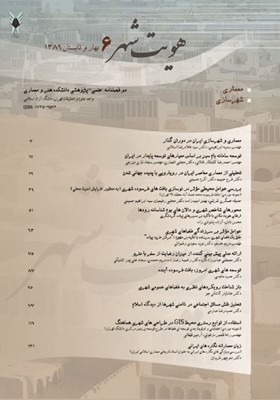تحلیلی از معماری معاصر ایران در رویارویی با پدیده جهانی شدن
محورهای موضوعی : معماری
1 - دانشیار دانشکده هنر ومعماری، دانشگاه آزاد اسلامی، واحد علوم و تحقیقات تهران، ایران. (مسئول مکاتبات)
2 - دانش آموخته دکتری معماری، دانشگاه آزاد اسلامی، واحد علوم و تحقیقات تهران، ایران
کلید واژه: Globalization, communication, معماری معاصر ایران, جهانیشدن, فن آوری ارتباطات, رایانه, Iranian Contemporary Architecture, computer technology,
چکیده مقاله :
پس از پیروزی انقلاب اسلامی وقوع تحولات گسترده ناشی از ارزش های انقلاب، همچنین نفوذ اندیشه های تکثرگرای پست مدرن غربی و تولید پارادایم هایی متفاوت با فرهنگ سنتی جامعه، سبب ایجاد دگرگونی های بسیاری در حوزه معماری گردید. در پی انقلاب فرهنگی، فقدان تحرک قابل ملاحظه در فعالیت های نظری و پژوهشی و نیز بستر شکل گیری نظریات معماری سبب گردید طراحان آن در پی ایجاد نسبتی نوین بین ساختار و محتوای آموزشی دانشگاه ها هم گام با شرایط نوین جامعه باشند. بدیهی است که این خواست ها بر روی همان محورهایی طرح شدند که شعارهای انقلاب مطرح می کرد. این امر در تناسب با روح عمومی جریانات هویت طلبانه معماری، ضرورت تغییر برنامه آموزشی معماری را نیز به جدیت طرح می کرد. این پژوهش به تبیین رویکرد معماری ایران در دوره بعد از انقلاب و تحلیل اهداف هویت طلبانه آن در برابر پدیده ای به نام جهانی شدن، ظهور فن آوری ارتباطات و رایانه خواهد پرداخت.
After victory of Islamic Revolution in 1360 (1981), wide mutations as a result of excited values of the Revolution caused lots of changes in different fields, including architecture. Following this, Cultural Revolution designers were adapted with new requirements of the community and orientations that introduced Revolution’s mottos after relative establishment of structure and educational contents of the universities. This matter, in conformity with general spirit of personality seeking processes of architecture, introduced necessity of changing in architecture training programs. In the field of architecture training, self-reversion , revival of past stable values, Permanent concepts are in history, structure and content of training program from the viewpoint of Cultural Revolution designers about importance of theoretical studies in training, joining of architecture training with precinct culture, historical examination of architecture before modernism, of national and zone perspective. Existence of word identity in the introduction of Cultural Revolution staff program in 1363 (1984), demonstrated attentions towards basics of new training program of architecture. Then, seeking identity in training process is followed by emphasizing on Islamic architectural history and Iranian architectural history. This period was contemporary with predominance of global process of postmodernism on West architecture. Postmodernism thoughts, criticizing inattention of modern architecture thinkers towards history of establishment of architecture in different places, chooses increasing, antonym, complex and metaphorical in its expressions. Prevalence of West postmodernism numerosity thoughts resulted in establishment of most of Iranian contemporary architecture works. On one hand, contemporary human’s social life, expansion of relationships and breaking boundaries are mixed with globalization idea. Contemporary world’s occurrences and mutations have widespread concepts in today life. Community technology, telecommunication, internet, satellite and so are things that involve human in network of relationships in different manners. So, after technical and technological advances of modernism, media could broadcast art and architecture mutations all around the world as other matters. Postmodernism attitude could increase its symbolic dimensions and attendance ways. Iran’s temporary architecture, which has a root in past architecture, is together with global widespread mutations, as a result of today world’s achievements and ideal that belongs to all of humans. Today architectures encounter with twosome status of doubt towards past values and captivation towards new values, as well as sentiment coherency to the past and excitement to the future; and this matter force them to search about recognition of personal and collective identity. Despite entering of current thoughts in West architecture to Iran, before entering and usage, tools and information technology was growing slowly and after the movement, it grows fast. It is necessary to evaluate reasons and results of these changes. While theoretical basics resulted from consideration of personality seeking, on one hand, and entrance of attitudes in West architecture on the other hand, (but without passing prerequisite processes that was caused appearance of the aforesaid thoughts), have significant influence on architecture of Iran. The present study involved in explaining Iran’s architecture approach after the Revolution and evaluating its personality seeking objectives against a phenomenon, called globalization, emersion of information technology, media and computers.
- اقبالی، سیدرحمان، (1378). «رساله دکتری»، «هویت معماری معاصرایران، بررسی تطبیقی نظریهها وتجربهها»، استاد راهنما:دکتر ایرج اعتصام،استادان مشاور: دکتر علی اکبر صارمی و دکتر ایرج تنهاتن ناصری، دانشکده هنرهای زیبا، دانشگاه تهران.
2- اعتصام، ایرج، (1374). «بررسی تطبیقی معماری و شهرسازی معاصر ایران با اروپا»، مجموعه مقالات اولین کنگره معماری و شهرسازی ایران، جلدسوم، تهران، انتشارات سازمان میراث فرهنگی کشور.
3- انصاری، حمیدرضا، (1385). «تحلیل معماری معاصر ایران»، گزارش درس«معماری معاصر» دوره دکتری دانشگاه تهران.
4- بذرافکن،کاوه، (1381). «نظامهای بیانی معماری و معماری ایرانی»، مجله معماری وشهرسازی، شماره 66.
5- بهنام، جمشید؛ جهان بگلو، رامین، (1382). «تمدن وتجدد«گفتگو»» ، تهران، تشر مرکز.
6- تافلر، آ، (۱۳۷۴). «موج سوم»، ترجمه شهیندخت خوارزمی، تهران، نشرخوارزمی.
7- حسینی، اکرم، (1387). «تبیین وتدوین گرایشهای معماری معاصرایران، با مطالعه معماری دهه 1385-1360 شهر تهران»، استاد راهنما: دکتر فرح حبیب، استاد مشاور: دکترایرج اعتصام، دانشگاه آزاد اسلامی، واحد علوم وتحقیقات.
8- جهانبگلو، رامین،(1384). «بین گذشته و آینده»، تهران، نشر نی.
9- علی محمدی، پریسا، (1385). «رساله دکتری»، «تاثیر تجربه با واسط جهانی در جهتگیری دانشجویان معماری معاصر ایران (بررسی موردی در دانشگاه تهران و دانشگاه آزاد اسلامی واحد تهران مرکز،در دهه 84-74)»، استاد راهنما: غلامرضا اسلامی،استاد مشاور:غلام حسین معماریان، دانشگاه آزاد اسلامی، واحد علوم وتحقیقات.
10÷- محمودی، محمدرضا، (1387). «جهانی شدن و معماری معاصر ایران»، مجله معماری وشهرسازی، شماره 89-88.
_||_
